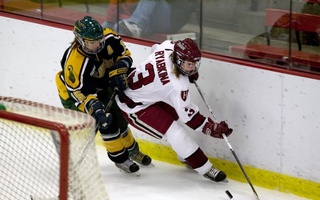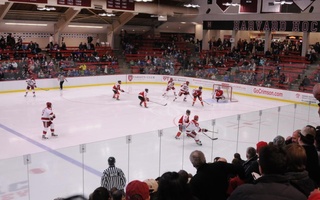
Seniors Alex Fallstrom (left) and Marshall Everson (right) were part of the nation’s most efficient power play during the 2011-12 season. With the departure of leading scorer and All-American Alex Killorn ’12, much of the scoring burden will fall to the pair, captain Danny Biega, and a group of highly-touted underclassmen.
During the 2011-12 season, the Harvard men’s hockey team’s power play was often marked by perfect precision.
With senior forward Alex Killorn and junior forwards Marshall Everson and Alex Fallstrom up front, rookie defenseman Patrick McNally behind them, and junior blueliner Danny Biega playing the point, the Crimson finished first in the nation with a 27.3 percent success rate.
The squad tallied a man-up goal in 23 of 28 regular season games and recorded a streak of 18 straight contests with a power-play score dating back to the 2010-11 season.
“The group last year was successful because of great teamwork,” Harvard coach Ted Donato ’91 says. “They shared the puck, they worked hard, and really there was no one person that we completely relied on.”
Indeed, each player on the unit had a role to fill. Everson’s job was to screen the goaltender’s vision inside, McNally’s was to prevent short-handed opponents from breaking loose, Killorn’s and Fallstrom’s was to attack the net, and Biega’s was to orchestrate everything from up top.
“We were able to adapt to a lot of different situations,” Everson says. “There were games when we’d score off the rush; there were games when we’d score off set plays. I think you just have to take whatever the penalty kill is giving you.”
But doing so will likely be tougher in the upcoming season, as Killorn has graduated and moved on to professional hockey. The production of the first-team All-American, who led the Crimson with 23 goals and 46 points last year, will be difficult to duplicate.
“I don’t think you can replace a guy like Alex Killorn,” Fallstrom says. “He was a phenomenal player.... We’re going to do all we can to fill the gap, but it’s not easy.”
To make up for the star’s departure, Everson says a number of players must become larger offensive threats.
“The way you replace someone like that is you need multiple guys to step up to account for the production that we lost,” the senior says. “There’s five or six guys that...[are] going to have to be impact players every night.”
“It would be a very difficult task for any one person to try to step into [Alex’s shoes],” Donato echoes. “But I do feel that we as a team can score more by committee. I think there’s more guys that are capable of having really big years for us. We have more depth up front, so we don’t have to be heavily relying on one line to score a goal.”
Among returning players, Everson and Fallstrom paced the squad with 13 tallies last year.
“[They both] had excellent, breakout-type seasons,” Donato says. “We’re going to need them to continue [building] on that and take it a step forward.”
Biega, one of the top offensive defenseman in the nation, scored 10 goals to go with his team-high 25 assists, while classmate Luke Greiner had nine tallies. McNally scored six—four on power plays—to go with 13 assists in man-up situations.
That type of returning depth—combined with an incoming freshman class ranked as the ECAC’s best by College Hockey News—has led both Biega and Everson to declare that this year’s offense is the strongest in their four years at Harvard.
Read more in Sports
An International Affair


















